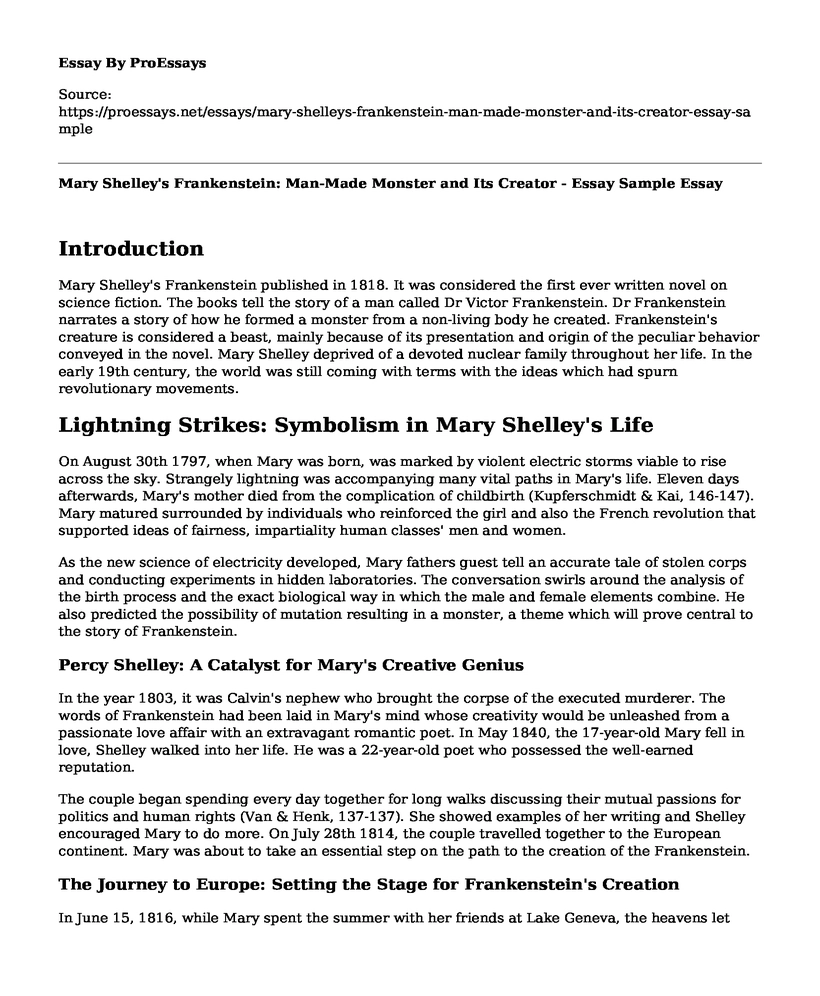Introduction
Mary Shelley's Frankenstein published in 1818. It was considered the first ever written novel on science fiction. The books tell the story of a man called Dr Victor Frankenstein. Dr Frankenstein narrates a story of how he formed a monster from a non-living body he created. Frankenstein's creature is considered a beast, mainly because of its presentation and origin of the peculiar behavior conveyed in the novel. Mary Shelley deprived of a devoted nuclear family throughout her life. In the early 19th century, the world was still coming with terms with the ideas which had spurn revolutionary movements.
Lightning Strikes: Symbolism in Mary Shelley's Life
On August 30th 1797, when Mary was born, was marked by violent electric storms viable to rise across the sky. Strangely lightning was accompanying many vital paths in Mary's life. Eleven days afterwards, Mary's mother died from the complication of childbirth (Kupferschmidt & Kai, 146-147). Mary matured surrounded by individuals who reinforced the girl and also the French revolution that supported ideas of fairness, impartiality human classes' men and women.
As the new science of electricity developed, Mary fathers guest tell an accurate tale of stolen corps and conducting experiments in hidden laboratories. The conversation swirls around the analysis of the birth process and the exact biological way in which the male and female elements combine. He also predicted the possibility of mutation resulting in a monster, a theme which will prove central to the story of Frankenstein.
Percy Shelley: A Catalyst for Mary's Creative Genius
In the year 1803, it was Calvin's nephew who brought the corpse of the executed murderer. The words of Frankenstein had been laid in Mary's mind whose creativity would be unleashed from a passionate love affair with an extravagant romantic poet. In May 1840, the 17-year-old Mary fell in love, Shelley walked into her life. He was a 22-year-old poet who possessed the well-earned reputation.
The couple began spending every day together for long walks discussing their mutual passions for politics and human rights (Van & Henk, 137-137). She showed examples of her writing and Shelley encouraged Mary to do more. On July 28th 1814, the couple travelled together to the European continent. Mary was about to take an essential step on the path to the creation of the Frankenstein.
The Journey to Europe: Setting the Stage for Frankenstein's Creation
In June 15, 1816, while Mary spent the summer with her friends at Lake Geneva, the heavens let loose Mary and Percy and the other friends stayed indoor. Lord Byron, the oldest of the group, proposed that everyone write their own ghost story. Mary left to sleep that night determined to create an exciting story that would express mysterious fears of our nature. When Mary went to sleep that night, she had a terrifying dream (Wijdicks & Eelco, 149-150). When she woke up the following day, she knew the story she was looking for had come to her mind, and that it should be known to the whole world.
Conclusion
In conclusion, the Frankenstein story is an autobiography of Mary Shelly. Because she wrote it, giving the experiences of her life. And the incidences that motivated her to come up with the story of Frankenstein. Frankenstein is not the monster but the monster Victor Frankenstein. Unlike the version of the stories told the creature is born innocent and useful only to be confronted by the world ego does he turn to murder. A creature considered as a beast, mainly because of its presentation and origin of the peculiar behavior conveyed in the novel. Mary Shelley deprived of a devoted nuclear family throughout her life.
Work Cited
Kupferschmidt, Kai. "The long shadow of Frankenstein." (2018): 146-147.
Van Den Belt, Henk. "Frankenstein lives on." (2018): 137-137.
Wijdicks, Eelco FM. "Reflecting on the Bicentennial of Mary Shelley's Frankenstein: From Novel to Film and the 2 Brains." JAMA neurology 75.2 (2018): 149-150.
Cite this page
Mary Shelley's Frankenstein: Man-Made Monster and Its Creator - Essay Sample. (2023, Feb 27). Retrieved from https://proessays.net/essays/mary-shelleys-frankenstein-man-made-monster-and-its-creator-essay-sample
If you are the original author of this essay and no longer wish to have it published on the ProEssays website, please click below to request its removal:
- The Greek Mythology and Its Influence on the Modern Societies
- Critical Essay on Brave New World: Narrative From John's Point of View
- Literary Analysis Essay on The Bean Eaters by Gwendolyn Brooks
- Literary Analysis Essay on Love in The Great Gatsby
- Comparing Plato's Allegory of the Cave to a Real-Life Situation
- Critical Essay on Hamlet Play by Shakespeare
- Paper Example on Chimney Sweeper's Agony: William Blake's Poems on Innocent Children's Suffering







